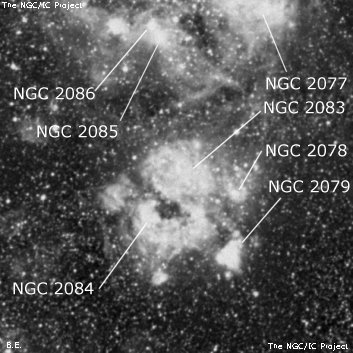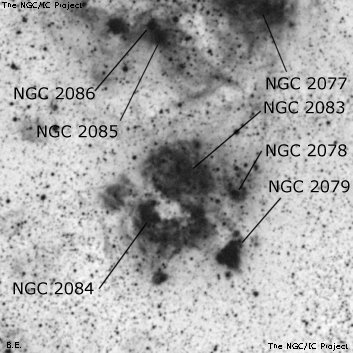NGC/IC Project Restoration Effort
(This is a very very beta version)
NGC2083


Basic Information
Location and Magnitude
Right Ascension: 5:39:59.3
Declination: -69:44:16
Constellation: DOR
Visual Magnitude:
Historic Information
Discoverer: Dunlop
Year of discovery: 1826
Discovery aperture: 9.0
Observational
Summary description: neb, nf of gr of 7
Sub-type: EN
Corwin's Notes
=====
NGC 2083. See NGC 2077.
Steve's Notes
=====
NGC 2083
24" (4/10/08 - Magellan Observatory, Australia): at 214x and UHC filter, NGC 2083 appeared as a bright, large, slightly elongated glow ~1.8' diameter, surrounding a mag 12.5 star (O-class supergiant). A brighter knot is embedded within the glow on the west side (LMC-N159I) on a line with NGC 2078. Removing the filter, the bright central star has a companion at ~7" and several other mag 14 stars are embedded in the periphery of the glow. On the southeast side is the 15th magnitude "star" N159-5, known as the LMC "Papillon Nebula". This very compact object (not resolved) is classified as a Young Stellar Object (YSO) and High Excitation Blob (HEB).
NGC 2083 is situated in the northeast section of the curving "S" shaped NGC 2078/79/83/84 complex (LMC-N159 and OB-association LH 105). This complex shares the same field with two additional bright emission regions - NGC 2085/86 4' N and NGC 2077/80 ~5.5' NNW (LMC-N160), and the combined complex forms a superb field of bright HII regions ~35' SSE of the center of the Tarantula Nebula. Although Herschel assigned 4 NGC numbers within LMC-N159, I logged at least 7 different brighter knots (see NGC 2084 for more).



